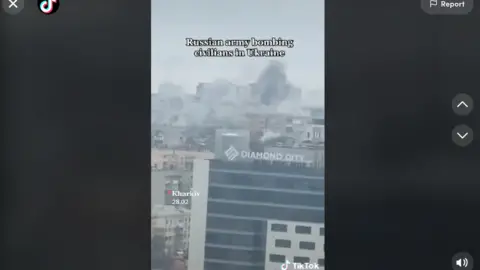Ukraine war: The TikToker spreading viral videos
Marta Vasyuta is a regular 20-year-old Ukrainian.
And like many people of her age she's on TikTok.
Until last week she had a few hundred followers on the video-sharing app. She posted videos from nights out, and lip-synced to her favourite music.
When Russia invaded Ukraine, she happened to be in the UK visiting friends she'd met at university.
She watched in horror at reports of Russian bombs falling on Kyiv.

What she did next turned Marta into a TikTok influencer - almost overnight.
Since 23 February, the videos she's posted from the conflict in Ukraine have garnered tens of millions of views. For many people on TikTok, and in particular younger people, she's become a key curator of news on the ground in Ukraine.
"I just want people to understand that Ukraine is not only a problem of Ukrainians, it's everyone's problem," she says.
Marta speaks fluent Ukrainian, Russian and English.
As soon as she heard about the invasion, she began to scroll though Ukrainian channels on the Telegram messaging app. Telegram is hugely popular in Ukraine.
People in Ukraine were uploading videos on to these channels. Marta trawled through and began to save them.
"My phone is completely filled with all the videos, all the news I found," she says.
She then went about trying to verify the videos, looking at the related comments. "I could see that people were saying that this was true, that this is what was going on right now."
She began to post the videos on to TikTok and then fell asleep.
"In the morning I woke and I checked my TikTok and they already had nine million views," she says.

Sam Gregory is the programme director of Witness, and looks at how social media is used during humanitarian crises. He says that TikTok's algorithm is aggressively topic-based.
"Content is served up to you based on your interests, not your feed," he says.
"So if you start to show interest in Ukraine, you're going to get shown more content that is either from Ukraine or talking about Ukraine".
It's helped people like Marta to become TikTok influencers, almost overnight. Her videos have had more than 17 million likes and she now has 200,000 followers.
She reads the numbers from her phone, still in disbelief, "saying those numbers I just can't comprehend it".
Experts, however, warn that although TikTok can be a good place to find videos from the ground, disinformation is also rife on the platform.
Marta admits that trying to verify content can be difficult. Even if a video is from Ukraine, and people are speaking Ukrainian, videos may still be from the long conflict in the east of the country that began in 2014. And she admits she is not an expert at verifying videos.
Some of the videos she has shared have been confirmed by news outlets as genuine, including the BBC.
But even so, she believes that some people would rather get their news from social media sources like her than from the traditional news outlets.
"Some people don't trust even professional journalists, even verified sources," she says.
For her, being a regular young woman from Ukraine, makes her relatable to a wider audience.
"That makes them trust me more, to trust my videos more," she says.
Marta has family in Ukraine and is worried about their safety. But by propagating these videos she believes she is helping the world, and particularly younger audiences, to see what is truly happening on the ground.
Given that she is now stuck in the UK, TikTok is her way of doing something.